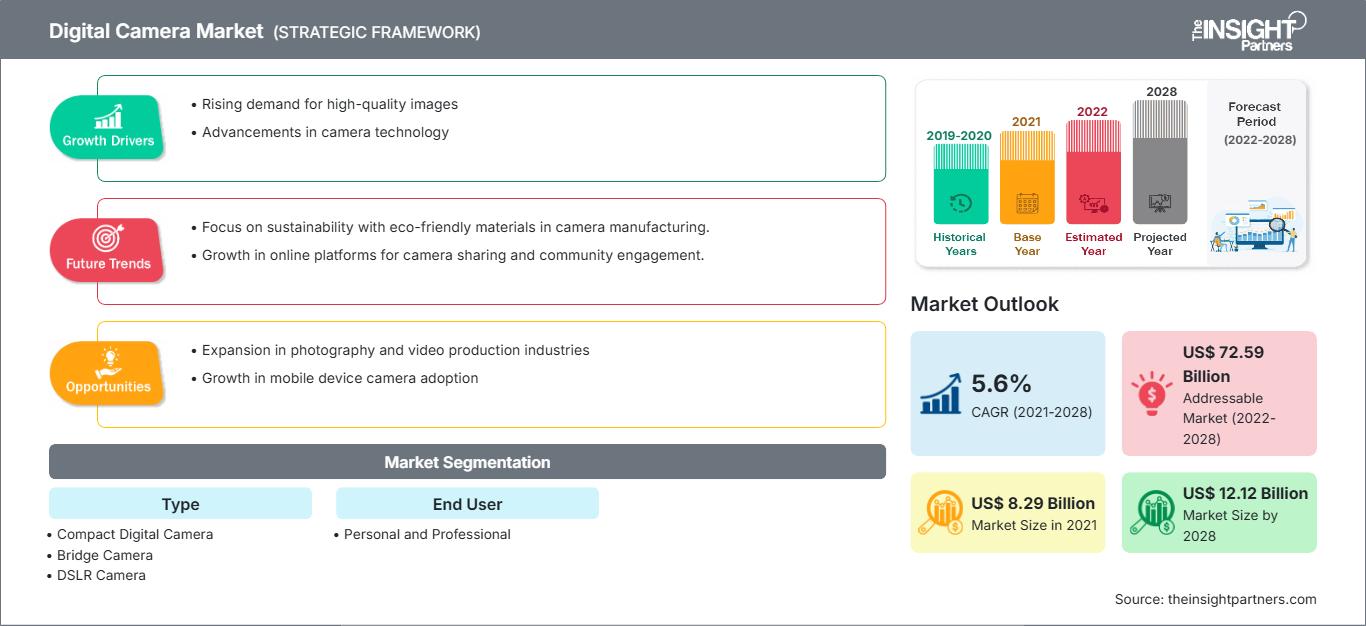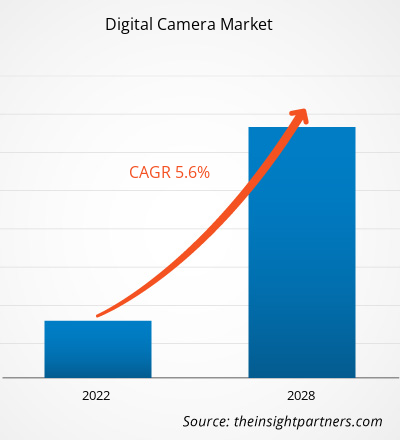디지털 카메라 시장은 2021년 82억 9,025만 달러에서 2028년 121억 1,944만 달러로 성장할 것으로 예상되며, 2021년부터 2028년까지 연평균 성장률 5.6%로 성장할 것으로 예상됩니다.
디지털 카메라의 사용은 개인 및 전문 사진 촬영에만 국한되지 않고 엔터테인먼트, 미디어, 스포츠 산업 전반에 걸쳐 확대되었습니다. 영화 산업은 세계 엔터테인먼트 산업에서 가장 크고 수익성이 높은 분야 중 하나입니다. 예를 들어, 중국의 영화 산업은 세계 최대 규모의 영화 산업 중 하나로, 2016년에는 약 66억 달러의 매출을 기록했습니다. 영화 및 엔터테인먼트 산업에 대한 이러한 긍정적인 전망은 완벽한 사진과 영상을 촬영하기 위한 디지털 카메라 수요를 견인할 것으로 예상됩니다. 급속한 기술 변화, 소비자 행동, 그리고 비즈니스 모델은 소비자가 엔터테인먼트와 미디어를 경험하고 비용을 지불하는 방식을 변화시켰습니다. 이 업계의 선두주자들은 뛰어난 콘텐츠 제작을 위해 팬 중심의 사업과 브랜드 구축에 집중하고 있습니다. 그 결과, 컴퓨터 생성 이미지(CGI), 시각 효과(VFX), 그리고 고급 카메라와 같은 기술과 장비에 상당한 투자를 하고 있습니다. 스포츠 미디어 분야에서도 디지털 카메라의 활용은 필수적입니다. 경기장에 고속 디지털 카메라를 설치하면 관중들이 중요한 경기 상황에서 슬로우 모션 리플레이를 볼 수 있고, 관전 중에도 정확한 영상을 얻을 수 있습니다. 마찬가지로, 야생 동물, 풍경, 건축물, 스튜디오 촬영에 고해상도 디지털 카메라를 사용하면 선명하고 깨끗한 이미지와 영상을 얻을 수 있습니다. 액션 사진에 대한 관심이 높아짐에 따라 GoPro와 같은 콤팩트 디지털 카메라에 대한 수요도 증가했습니다. 또한, 인스타그램과 같은 소셜 미디어 플랫폼의 등장으로 사진 촬영의 영역이 크게 확장되었으며, 이는 디지털 카메라 시장의 성장을 가속화할 것으로 예상됩니다.
이 보고서의 일부, 국가 수준 분석, Excel 데이터 팩을 포함하여 모든 보고서에 대한 사용자 정의를 무료로 받을 수 있을 뿐만 아니라 스타트업 및 대학을 위한 훌륭한 제안 및 할인을 이용할 수 있습니다
디지털 카메라 시장: 전략적 통찰력

-
이 보고서의 주요 주요 시장 동향을 확인하세요.이 무료 샘플에는 시장 동향부터 추정 및 예측에 이르기까지 데이터 분석이 포함됩니다.
코로나바이러스 팬데믹은 봉쇄, 여행 금지, 사업 중단으로 인해 여러 국가의 경제와 산업에 영향을 미쳤습니다. 가전제품 산업은 이러한 팬데믹으로 인해 공급망 붕괴, 생산 공장 폐쇄 등 심각한 차질을 겪고 있는 주요 산업 중 하나입니다. 북미, 유럽, 아시아 태평양, 남미, 중동, 아프리카 등 주요 지역의 여러 제조 공장과 공장 폐쇄는 글로벌 공급망에 영향을 미치고 다양한 제품의 제조, 배송 일정 및 판매에 부정적인 영향을 미쳤습니다. 더욱이 여러 기업들이 제품 배송 지연 및 향후 판매 부진 가능성을 이미 발표했습니다. 또한 유럽, 아시아, 북미 국가들이 시행한 전 세계 여행 금지 조치는 기업 협력 및 파트너십 기회에 영향을 미치고 있습니다. 이러한 모든 요인은 가전제품 산업에 부정적인 영향을 미쳐 향후 몇 달 동안 관련 시장의 성장을 저해하는 요인으로 작용할 것으로 예상됩니다. 디지털 카메라 시장은 생산량 부족과 운송 시설 부족으로 인해 팬데믹의 영향을 받고 있습니다.
디지털 카메라 시장 분석: 디지털 카메라 관련 기술 혁신이 디지털 카메라 시장 성장을 촉진합니다.
디지털 카메라 시장은 HD 및 터치스크린과 같은 혁신적인 기술 개발과 탄탄한 발전을 바탕으로 급진적인 트렌드가 부상하고 있습니다. 오랫동안 소비자들의 고급 사진 촬영에 대한 관심이 높아짐에 따라 디지털 일안 반사식(SLR) 카메라와 SLR 카메라 시장에 대한 수요가 증가해 왔습니다. 하지만 기술 발전으로 12~20메가픽셀의 고해상도 카메라가 개발되었습니다. 디지털 카메라 분야의 지속적인 발전으로 더 높은 해상도, 빠른 초점, 다양한 주변 장치 지원을 갖춘 고급 카메라가 개발되었습니다. 또한, 디지털 카메라에 Wi-Fi 또는 4G 모뎀을 통합하는 추세가 증가하면서 스마트폰 대비 경쟁력을 확보할 수 있는 것으로 나타났습니다. 더욱이, 이러한 카메라는 사물 인터넷(IoT)과 같은 여러 상호 연결된 기기의 일부가 될 것으로 예상되며, 가까운 미래에 스마트폰이나 스피커 어시스턴트와 같은 다른 상호 연결된 기기와의 효과적인 통신을 가능하게 할 것입니다.
유형별 시장 분석
디지털 카메라 시장은 유형에 따라 컴팩트 디지털 카메라, 브리지 카메라, DSLR 카메라, 미러리스 카메라, 디지털 레인지파인더 카메라, 라인 스캔 카메라로 분류됩니다. 2020년에는 DSLR 카메라 부문이 시장에서 가장 큰 점유율을 차지했습니다.
디지털 카메라 시장 지역별 통찰력
The Insight Partners의 분석가들은 예측 기간 동안 디지털 카메라 시장에 영향을 미치는 지역별 동향과 요인들을 면밀히 분석했습니다. 이 섹션에서는 북미, 유럽, 아시아 태평양, 중동 및 아프리카, 그리고 중남미 지역의 디지털 카메라 시장 부문 및 지역별 현황도 살펴봅니다.
디지털 카메라 시장 보고서 범위
| 보고서 속성 | 세부 |
|---|---|
| 시장 규모 2021 | US$ 8.29 Billion |
| 시장규모별 2028 | US$ 12.12 Billion |
| 글로벌 CAGR (2021 - 2028) | 5.6% |
| 이전 데이터 | 2019-2020 |
| 예측 기간 | 2022-2028 |
| 다루는 세그먼트 |
By 유형
|
| 포함된 지역 및 국가 |
북미
|
| 시장 선도 기업 및 주요 회사 프로필 |
|
디지털 카메라 시장 참여자 밀도: 비즈니스 역학에 미치는 영향 이해
디지털 카메라 시장은 소비자 선호도 변화, 기술 발전, 그리고 제품 장점에 대한 인식 제고 등의 요인으로 인해 최종 사용자 수요가 증가함에 따라 빠르게 성장하고 있습니다. 수요가 증가함에 따라 기업들은 제품 라인업을 확장하고, 소비자 니즈를 충족하기 위한 혁신을 추진하며, 새로운 트렌드를 적극 활용하고 있으며, 이는 시장 성장을 더욱 가속화하고 있습니다.

- 을 얻으세요 디지털 카메라 시장 주요 주요 플레이어 개요
디지털 카메라 시장은 용도에 따라 개인용과 전문가용으로 구분됩니다. 2020년에는 전문가용 부문이 더 큰 시장 점유율을 차지했습니다.
디지털 시장에서 활동하는 업체들은 시장에서의 입지를 유지하기 위해 인수, 합병, 시장 주도권 확보 등의 전략을 채택하고 있습니다. 주요 업체들의 몇 가지 동향은 다음과 같습니다.
- 후지필름 홀딩스(FUJIFILM Holdings Corporation)는 2021년 2월 말 후지필름 GFX100S 출시를 발표했습니다. 이 카메라는 GFX 시리즈 미러리스 디지털 카메라의 최신 제품입니다.
- 니콘(Nikon Corporation)은 풀프레임 미러리스 카메라 Z 7II를 출시했습니다. Z 7II는 풀프레임 고해상도 미러리스 카메라입니다. 이러한 제품 출시를 통해 회사는 영상 문화 발전에 기여하고 있습니다.
디지털 카메라 시장은 다음과 같이 세분화되었습니다.
유형별
- 콤팩트 디지털 카메라
- 브리지 카메라
- DSLR 카메라
- 미러리스 카메라
- 디지털 레인지파인더 카메라
- 라인 스캔 카메라
최종 사용자별
- 개인용
- 전문가용
지역별
-
북부 아메리카
- 미국
- 캐나다
- 멕시코
-
유럽
- 프랑스
- 독일
- 이탈리아
- 영국
- 러시아
- 유럽의 나머지 지역
-
아시아 태평양(APAC)
- 중국
- 인도
- 대한민국
- 일본
- 호주
- APAC의 나머지 지역
-
중동 및 아프리카(MEA)
- 남아프리카공화국
- 사우디아라비아
- UAE
- MEA 기타 지역
-
남아메리카(SAM)
- 브라질
- 아르헨티나
- SAM 기타 지역
회사 프로필
- 캐논(Canon Inc.)
- 이스트먼 코닥(Eastman Kodak Company)
- 후지필름 홀딩스(Fujifilm Holdings Corporation)
- 라이카 카메라(Leica Camera Ag)
- 니콘(Nikon Corporation)
- 옴 디지털 솔루션즈(Om Digital Solutions Corporation)
- 파나소닉(Panasonic Corporation)
- 하셀블라드(Hasselblad)
- 리코 이미징(Ricoh Imaging Company, Ltd)
- 소니(Sony Corporation)
- 과거 분석(2년), 기준 연도, CAGR을 포함한 예측(7년)
- PEST 및 SWOT 분석
- 시장 규모 가치/거래량 - 글로벌, 지역, 국가
- 산업 및 경쟁 환경
- Excel 데이터세트
최근 보고서
관련 보고서
사용 후기
구매 이유
- 정보에 기반한 의사 결정
- 시장 역학 이해
- 경쟁 분석
- 고객 인사이트
- 시장 예측
- 위험 완화
- 전략 기획
- 투자 타당성 분석
- 신흥 시장 파악
- 마케팅 전략 강화
- 운영 효율성 향상
- 규제 동향에 발맞춰 대응






















 무료 샘플 받기 - 디지털 카메라 시장
무료 샘플 받기 - 디지털 카메라 시장